New York City is a metropolis, also known as the Big Apple, and it is the epitome of the United States and much of what the United States stands for in diversity, opportunities and freedom. It is an international metropolis that attracts tourists from all over the world all year round, and there is always something exciting to see and do in this, the largest American city.
Upon entering the city the Statue of Liberty stands as a symbol of the land of the free and the American dream, which has always been popular among immigrants and tourists alike. The statue goddess overlooks Manhattan’s mix of the many classic and modern skyscrapers, bridges, rivers and many other sights and features.
It was in New York and Chicago, the world’s first and tallest classic high-rise buildings were built, and it happened fast and ever higher through the 20th century. Among the most famous skyscrapers, you can see the Chrysler Building and the Empire State Building from the peak of skyscraper designs on the first part of the 1900s. One World Trade Center is the tallest and the most famous modern high-rise in the city.
New York is also synonymous with shopping malls and great food. Walk the elegant Fifth Avenue or the world’s largest department store, Macy’s, and enjoy the cityscape with cafes and restaurants from all over the world. It is never far to another good cafe or place to eat in the various ethnic neighborhoods.
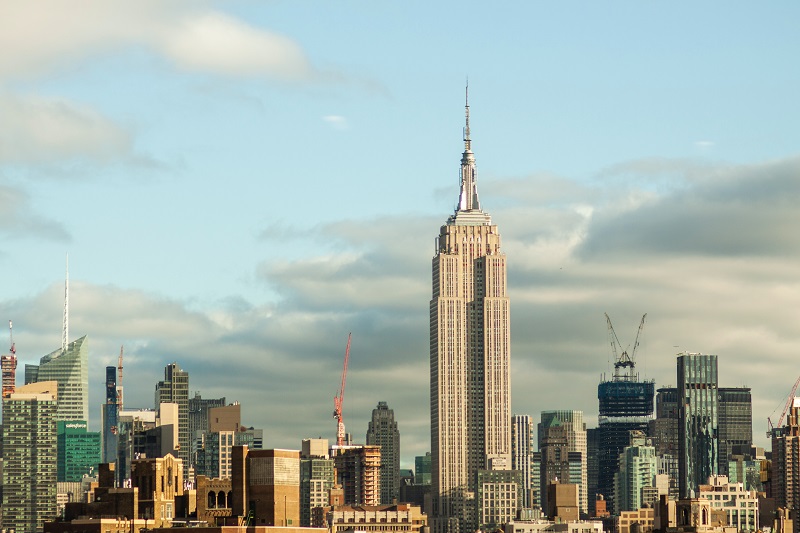
Empire State Building is an iconic skyscraper that was built between 1929 and 1931 as the world’s tallest skyscraper. The height to the top of the building’s antenna is a whopping 443 meters, and this was only surpassed with the construction of the twin towers of the World Trade Center in 1970. The Empire State Building was built in Art Deco style with many fine details already visible in the lobby.
The name comes from the state of New York’s nickname, the Empire State. There is also something almost majestic about the building, whose powerful spiers at the top, which were also designed in elegant art deco, were originally intended as a mooring place for the airships of the time, not least known as the German zeppelins.
You can take one of the building’s 73 elevators or the 1,860 steps to the regular observation deck on the 86th floor, where from a height of 320 meters you can enjoy what is probably New York’s most fascinating view. There are 102 floors in total, and the Empire State Building was the first skyscraper with more than 100 floors. The difference from the 86th to the 102nd floor is made up by the large art deco top under the antenna itself. There is also a small observation deck on the 102nd floor, and this place was originally part of the reception area for airship travelers who, however, did not dock here.

Times Square is a square that was named after the New York Times newspaper, which built its headquarters here in 1904. The New York Times building is still located here with the address 1 Times Square.
The newspaper started the world’s first illuminated newspaper in the 1920s, and the square has since been enriched with a multitude of neon and screen advertisements like nowhere else in the city. The image of the illuminated Times Square is one of the well-known portraits from New York that most people will nod in recognition of.
The square is the center of New York’s New Year celebrations, and a special event is the so-called Ball Drop. Ball Drop is an event where an illuminated crystal ball is lowered, making way for the New Year.
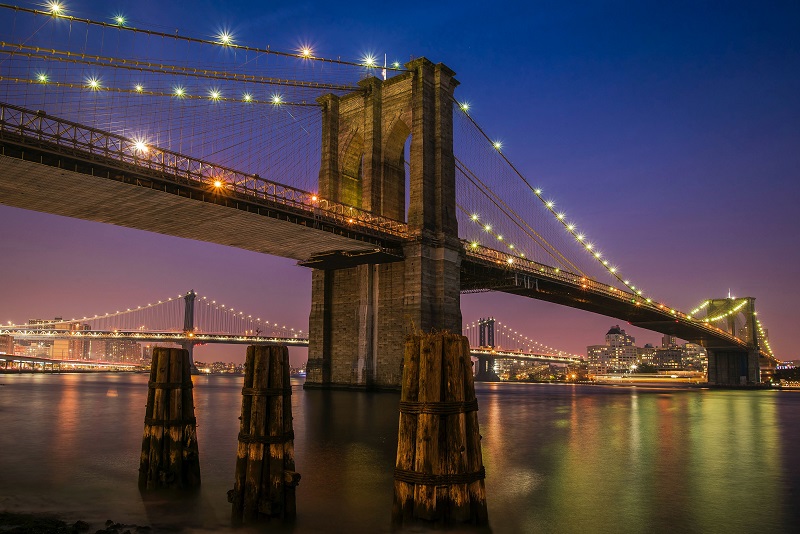
Brooklyn Bridge is a beautiful bridge that was built 1869-1883 by German John Augustus Roebling as the world’s first steel suspension bridge. It is no less than 1,091 meters long, which was a true engineering achievement at the time. The bridge revolutionized traffic between the two cities of New York and Brooklyn, and it is today one of New York’s landmarks.
You can cross the bridge on the pavement located centrally on the bridge, which is raised 5.5 meters above the roads below. The impression from here of the bridge’s construction is impressive, and the view is very nice all the way across. The trip between the pylons and thus the span of the bridge is 487 metres.
The opening of the Brooklyn Bridge took place on May 24, 1883, when US President Chester A. Arthur and New York City Mayor Franklin Edson crossed the bridge from Manhattan to Brooklyn, where they were greeted by Brooklyn Mayor Seth Low. On the first day, 1,800 vehicles and more than 150,000 pedestrians passed the bridge, which was then the only fixed link over the East River.

Chrysler Building is one of New York’s most famous skyscrapers. It was built by car manufacturer Walter P. Chrysler, and it was completed in 1930. At 319 meters, the Chrysler Building was the world’s tallest building when it opened, and many still consider it one of the most beautiful buildings in New York.
The building was designed by William Van Alen and styled in Art Deco. You can see many details in the design that show the builder’s background. This concerns, for example, the figures on the roof, which were inspired by the radiators of the car models.
The beautiful edifice was constructed at high speed in a New York where several were fighting to build the world’s tallest skyscrapers and buildings. At that time, the Eiffel Tower in Paris was the tallest structure in the world. In the case of the Chrysler Building, the competition was the H. Craig Severance high-rise at 40 Wall Street.
Severance increased his project by 23 meters and took the title by this maneuver. The victory was short-lived, however, as Van Alen added a 100-foot-tall antenna to the Chrysler Building, which could be kept secret by being submerged for a time during the actual construction of the building. The Chrysler Building was the world’s tallest building until 1931, when the Empire State Building was made even taller.
A curiosity is that Walter P. Chrysler personally paid for the construction, and it was thereby owned by himself and never by the Chrysler company. Chrysler did this to ensure that his children could inherit the high-rise.
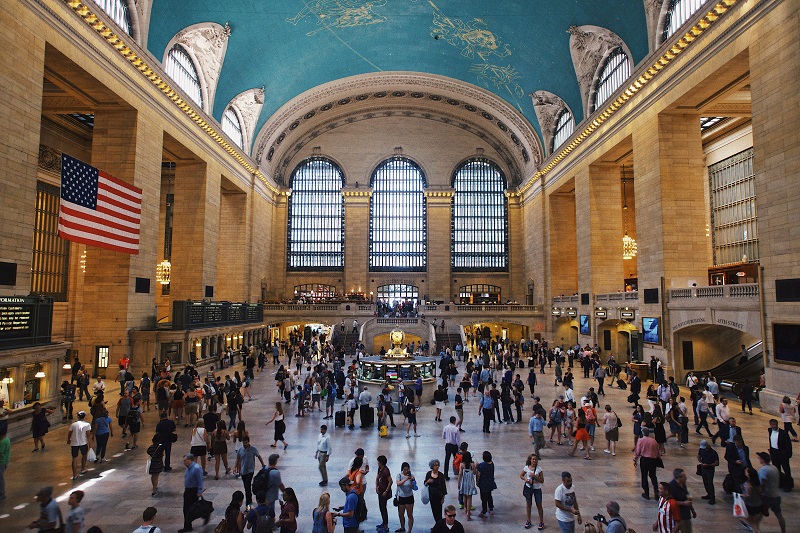
Grand Central Station is New York’s huge main railway station, which was inaugurated in 1913. The style is impressive beaux arts like several other great constructions of the time. Despite ongoing expansion, the former railway station had become too small, and that was the reason for the construction of Grand Central Station.
In addition to its impressive size with many underground tracks on several levels, it is not least the large central station hall that makes the building worth seeing. It was built with details that evoke memories of the golden age of railways. The station and the central station hall are also known from several movie scenes that have been filmed at the site over the years.
A particularly well-known detail in the decoration is the station clock, which can be found in the station hall. It was designed by Henry Edward Bedford and made of brass with opal glass on the four sides. Another clock adorns the facade above the entrance from 42nd Street. It has a diameter of four meters and was crafted in Tiffany glass. Around the clock you can see a sculpture group by the French sculptor Jules-Felix Coutan. The statues depict Hercules, Mercury and Minerva.

The Metropolitan Museum of Art is one of the world’s largest art museums, and it contains a very large collection of works from prehistoric times to the present day. There are collections from all major cultures and periods, and you can spend a long time on a visit. Among the countless highlights are the 15 AD Roman Temple of Dendur, Rembrandt’s 1660 Self-Portrait and works by El Greco, Johannes Vermeer, Francisco Goya, Paul Gauguin, Katsushika Hokusai and many more.
The museum was founded as an institution in 1870, and the imposing main building was built in beautiful Beaux-Arts, opening in 1874. Since then, the museum has expanded, and over the years it has developed into the largest art museum in the United States.
In 1888, a competition was announced for the construction of the Cathedral of Saint John the Divine, planned to be the largest cathedral in the world. The winning project was a church with clear Gothic features and inspiration from French cathedrals such as the one in the city of Chartres.
The foundation stone was laid in 1892, and parts of the church have been continuously completed over time, however, with a long break starting with the Second World War. Construction is still underway on the mighty cathedral, which measures 183×45 meters with 38 meters to the top of the ceiling.
The church draws both on the style of medieval Gothic cathedrals and on elements from modern American society. An interesting detail is the many glass mosaics that depict life in the United States. You can see sports such as bowling and baseball, an ecological motif and modern communication with an image of a television.
The many details and the long construction time are a deliberate choice, as Saint John the Divine is being built using the techniques that have made European cathedrals stand for many centuries. The idea is to create a structure that is durable and at the same time can itself be considered one of the old cathedrals one day.
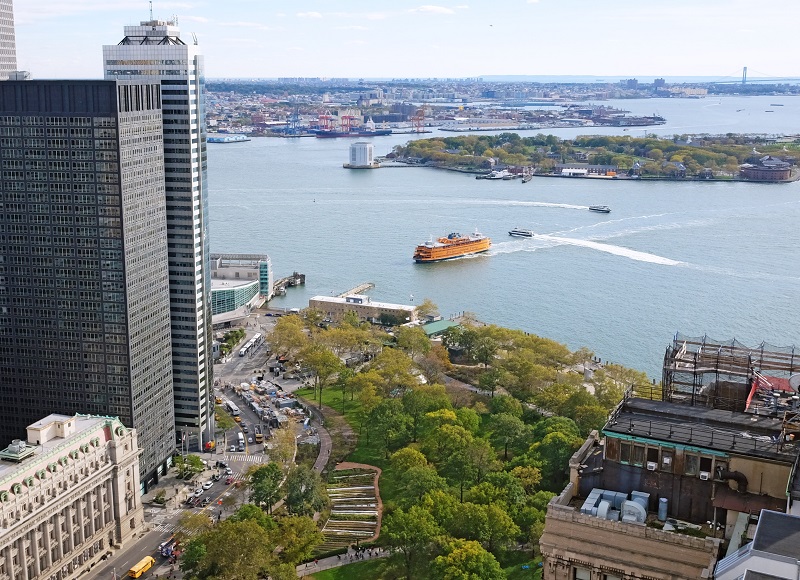
Battery Park is a beautifully situated oasis, from which there is also a lovely view of the water and to the skyscrapers of the financial district. Battery Park is named after the cannon batteries that were located here in the past, and which formed the city’s defense against the waterfront.
In Battery Park you can see the fortress Castle Clinton, which was built in the years 1808-1811. Originally it was in the water as a sea fort, but landfills have made it land-locked. In 1821 the fort closed as a military facility, and over time there has been a theater and an aquarium here. Today it is a visitor center where you can explore selected parts from New York’s history.

World Trade Center is synonymous with the attack on September 11, 2001, when planes were flown into the twin towers, which then constituted the World Trade Center’s iconic buildings. Today, Ground Zero is where the twin towers of the World Trade Center stood until 2001, when two airliners were flown into the buildings and crashed, killing thousands.
The World Trade Center was a complex consisting of a total of seven buildings, of which the 417 meter high twin towers were the most famous and which marked the peak of the city’s profile. The construction of the towers lasted from 1966 to 1971, and as mentioned, they were destroyed during the attack on the United States in 2001.
In 2006, the Port Authority, which owns the site, began construction of the foundation for the site’s new tallest building, named One World Trade Center. Also known as the Freedom Tower, One World Trade Center was officially opened in November 2014. One World Trade Center’s roof reaches a height of 417 meters, while the tip of the building’s antenna extends to 541 meters, making the building one of the world’s tallest buildings.
The height itself is symbolic in two ways. The 541 meters is equal to 1,776 US feet, which is the same number as the year of the signing of the American Declaration of Independence. The 417 meters is the same height as the original twin towers of the World Trade Center.
At the former location of the twin towers, a national memorial has been established today for those who died on September 11, 2001. The opening took place on the tenth anniversary of the attack, and the memorial is called the National September 11 Memorial & Museum, and it consists of a park around the site of the two crashed twin towers. The very site of the former outer walls of the two towers is marked by two rectangular basins; North Pool and South Pool. The site’s museum opened in 2014 and depicts September 11, 2001 through objects, stories, photographs and more.
Saint Paul’s Chapel is a charming church built in 1766. Back then, the church was outside the city and served as a church for those who lived in the countryside. It was Britain’s Queen Anne who donated the land for what is now Manhattan’s oldest surviving church.
The building style was Georgian, and the church was inspired by buildings in London such as St Martin-in-the-Fields. St Paul’s Chapel has a classic columned hall as a facade, and behind it you can experience an elegant and bright interior.
Among the churchgoers over time have been America’s first president, George Washington, and the later King William IV of England. Washington even visited the church on his inauguration day as president, which was April 30, 1789. In and around the church you can see several monuments erected to some of the people who have been important to the country or to the church.
In connection with the attack on New York in 2001, when the World Trade Center’s skyscrapers crashed into rubble almost next door to Saint Paul’s Chapel, the church was completely intact, and there was not even a broken window. It was therefore natural that the church was used as a kind of refuge on top of the events that had taken place.
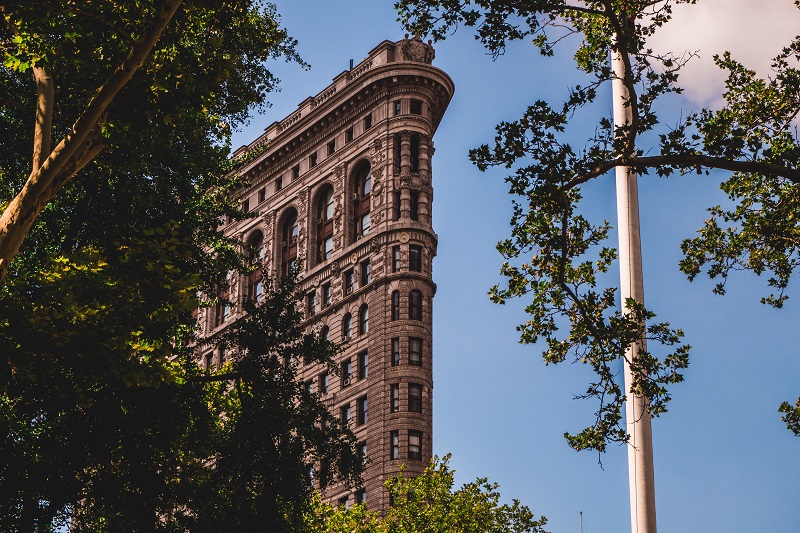
The Flatiron Building was erected in 1903 as the tallest building in the world. It was one of the first modern skyscrapers to use a steel skeleton in the construction to achieve the previously unseen heights. Daniel Burnham from Chicago was the architect of the innovation, and the architectural style was inspired by both Renaissance mansions and the Beaux-Arts of the time.
The Flatiron Building was not just one of the early pioneering high-rise buildings, it was also an example of the Chicago School style in New York. The Chicago School differed from the New York architectural style by being built like a now classic skyscraper without a separate base and with large glass sections without much use of decoration.
Opposite the building is a small and cozy park in Madison Square, where many locals go for a walk or sit and relax. Here you can see a number of statues that were erected in the 1800s.

Woolworth Building is one of New York’s oldest skyscrapers, and one of the most beautiful and best-known high-rises. The building, with its impressive 55 floors and 241 metres, was already constructed in the years 1910-1913. The style was inspired by Europe’s soaring Gothic.
The building was designed by the architect Cass Gilbert and erected as the headquarters of the Woolworth company. Woolworth was not least known for its department stores of the same name, and it was Frank Woolworth who started construction after purchasing the land in 1910.
Upon its opening in 1913, the Woolworth Building assumed the distinguished status of the world’s tallest building. Incidentally, the lights were officially lit by President Woodrow Wilson at the inauguration, and it happened from the capital Washington.
The building’s exterior is matched by an elegantly decorated interior, where the lobby stands as one of the most beautiful from the early 20th century in New York City. Frank Woolworth’s preserved office, kept in the French Empire style, is another attraction in the building.
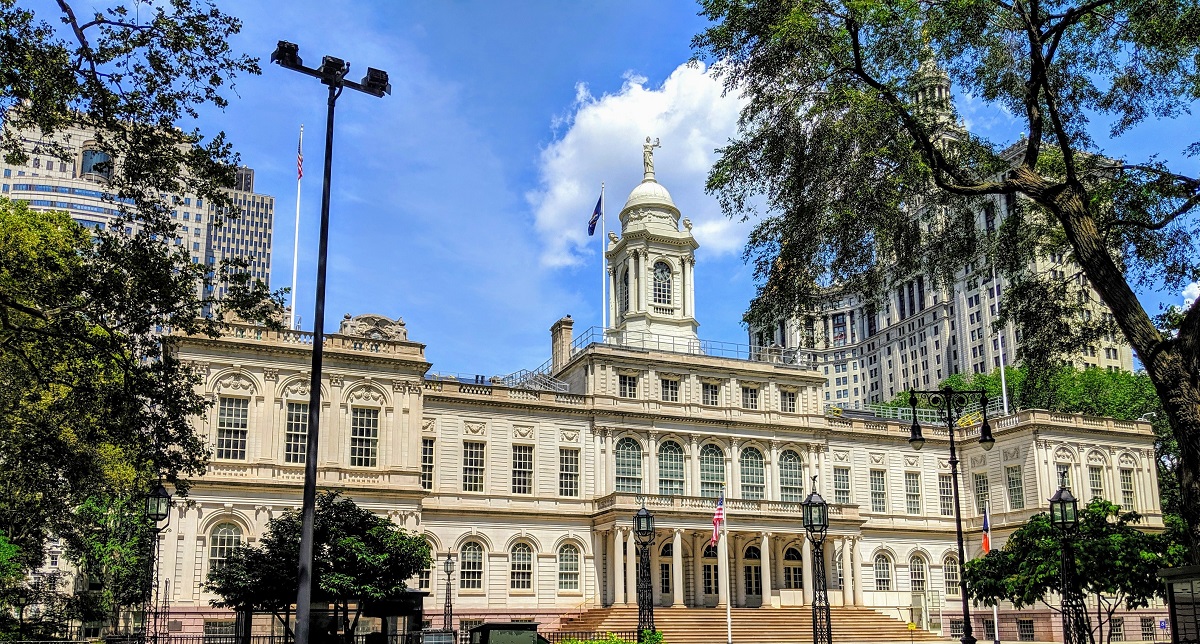
City Hall is New York’s seat of the city administration and it dates from 1812. It is one of New York’s most architecturally elegant buildings, and it stands in the middle of the lovely oasis that is the surrounding City Hall Park. The park, with its trees and fountains, is a true breather between the tall buildings that surround the facility.
The building style of the town hall is like a mansion from the American southern states. The lobby is beautiful with its rotunda, columns and staircase. The building houses New York’s mayor’s office and is where the city council have their meetings, making it the oldest functioning city hall in the United States. There are also a number of works of art in the town hall like John Trumbull’s painting of Alexander Hamilton. This work adorns the US 10 dollar bill today.
There are many historical events that have taken place in the city hall building. One of the most famous was when the assassinated President Abraham Lincoln lay on lit de parade in the building after his death in 1865.
New York’s first City Hall was built by the Dutch in the 17th century near the current address of 73 Pearl Street. The second town hall was completed in 1700 at the corner of Wall Street and Nassau Street. It was Federal Hall, which was demolished in 1812. Since then, the current City Hall has served as the city’s administrative seat.

Manhattan Bridge is one of the great old bridges over the East River between the boroughs of Manhattan and Brooklyn. Opened in 1909, the suspension bridge was constructed on two levels, with road lanes at the top and mixed traffic with road lanes, railway tracks, cycle paths and footpaths at the bottom.
The total length of the bridge is 2,090 metres, and the free span between the pylons is 448 metres. From bank to bank of the East River, which despite its name is a strait and not a river, is 890 meters.
As a grand entrance to the bridge and as part of the contemporary urban beautification project called City Beautiful, the firm Carrère and Hastings designed a triumphal arch with two colonnades. It was completed in 1915 and can still be admired on the Manhattan side of the impressive suspension bridge.
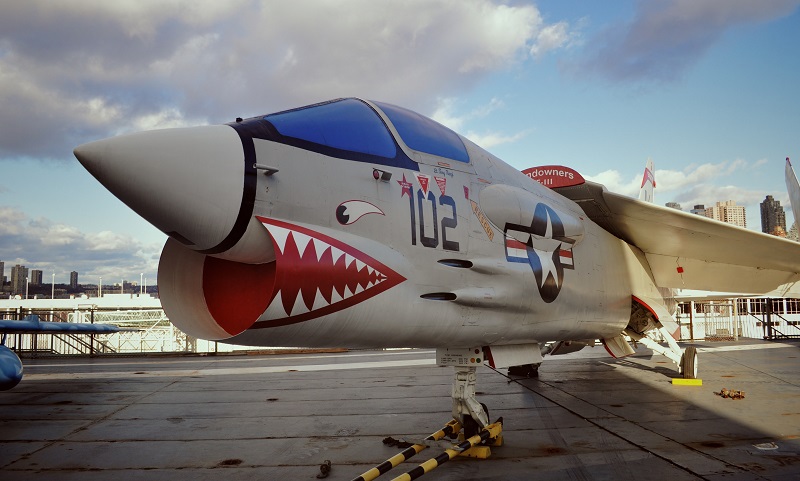
Intrepid Sea-Air-Space Museum is a museum located on and around the American aircraft carrier USS Intrepid, which was in active service 1943-1974. The ship was involved in the Pacific War during World War II and later also participated in the Vietnam War. The ship was fitted out as a museum ship in 1982.
In addition to being able to experience an impressive aircraft carrier, you can also see other things. For example, the submarine USS Growler is also located here, it was in service 1958-1964. It was part of the navy’s reserve until 1980, and it was then intended to use it as a torpedo target. It was not carried out and instead visitors to New York can now look at it.
There are also airplanes in the exhibition. You can see a British Airways Concorde (G-BOAD) that flew between London and New York. Concorde was the world’s second supersonic passenger plane after the Soviet Tupolev 144. Of military aircraft, you can see, for example, an F-16, Lockheed A-12, an AV-8C Harrier and a MiG-17. Of the other aircraft, the space shuttle Enterprise came to the museum in 2012, and there is thereby also space travel history here in the middle of New York.
South Street Seaport is a central part of New York’s old harbor area, which is now renovated and full of a variety of attractions. Pier 17 is a center with a number of shops and eateries. The center is right next to the harbor, where you can enjoy a very nice view of the Brooklyn Bridge and go on a boat trip in the harbor.
In the area you will also find the maritime museum, South Street Seaport Museum, where you can see historic ships and get an overview of the history of the port of New York. The Titanic Memorial Lighthouse is also located here, which is a lighthouse that was erected in 1913 in memory of the victims of the sinking of the luxury liner Titanic. Schermerhorn Row is interesting to see as well. It is a series of houses that were built in 1811 as warehouses.
In 2012, the South Street Seaport was significantly damaged after Superstorm Sandy. The local museum had to close for a time, and a number of shops had to close. In 2013, the distinctive Pier 17 building was demolished. A new building has since been erected, and there is access to the new surroundings in the well-located location.

Rockefeller Center is a building complex that the wealthy John D. Rockefeller built in the years 1930-1939. Back then, the centre’s original 14 buildings were built, and today the complex has been expanded to 19 buildings. The style is art deco, and the harmony between the buildings and the streets is particularly fine, which makes the place much visited by New Yorkers.
Originally, it was Rockefeller’s idea to let a new opera house for the Metropolitan Opera form part of a building complex, but after the stock market crash in 1929, he chose to go ahead as the only one to finance a large construction here. It then also became the largest privately financed project in the world at the time, and it was in this connection that the first 14 buildings were erected with Raymond Hood as lead architect.
In 1931, John D. Rockefeller was suggested the name Rockefeller Center, which he did not want at first, but due to the consideration of being able to attract more tenants, it was adopted. Thus, the place housed a number of offices, and part of the center also formed intelligence headquarters during World War II, which happened in Room 3603.
In the 1960s and 1970s, the number of buildings was expanded from 14 to 18 with the construction of four building towers in the contemporary international style, and today there are 19 buildings in the large complex.
There is quite a bit of art around Rockefeller Center. For example, you can see works by Lee Lawrie, who among other things created the statue of Atlas, which can be seen towards the street 5th Avenue. You can also notice some reliefs such as Isamu Noguchi’s News, which can be seen at the Associated Press Building (50 Rockefeller Plaza).
One of the best-known works of art is probably Paul Manship’s gilded bronze statue of the titan Prometheus, who in Greek mythology gave fire to mankind. It can be seen at the Lower Plaza, which is also the setting for the complex’s popular skating rink. At Christmas time, it is also something special to see the center in its entirety, which is characterized by beautiful illumination and a fantastic New Yorker atmosphere.
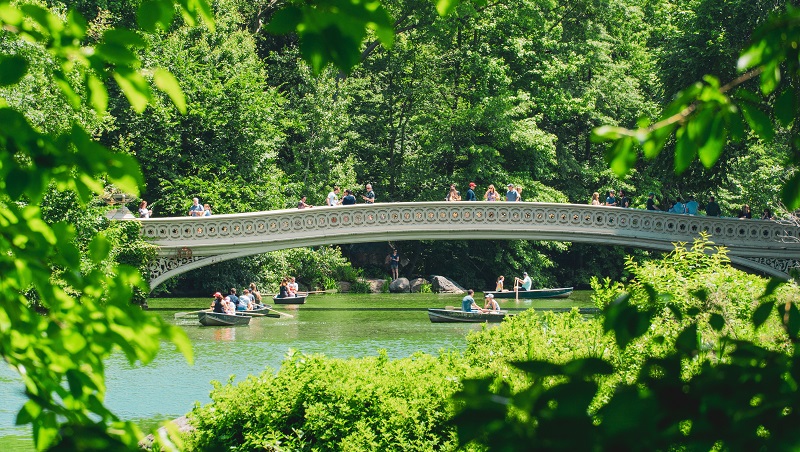
Central Park is New York’s large city park, measuring 4,000×800 metres. The park was planned by the city council in 1853 and laid out in the following years, when the city’s population almost exploded, and where people wanted a park like Hyde Park in London or the Bois de Boulogne in Paris.
In the park’s many nooks and crannies and on the many kilometers of footpaths, you can get a view of the recreation of many New Yorkers with, for example, jogging and various sports. You can also simply go for a walk in the beautiful surroundings and enjoy the view of many of the fashionable buildings that were built along the sides of the park over time.
In Central Park you can find several statues and sculptures such as those on the so-called Literary Walk with authors, and then there is the ancient Egyptian obelisk Cleopatra’s Needle, which came here as a gift from Egypt. The obelisk is one of a pair, the other standing in London, England. Each of them is 21 meters high and originates from Heliopolis from the time of Thutmose III around the year 1450 BC. The obelisks are of granite and their inscriptions date from the time of Ramses II in the 13th century BC.
In Central Park, there are artificial lakes, large lawns and the Belvedere Castle, built in 1869, which has functioned both as a viewpoint and as a weather station. There is also a zoo in Central Park, and there are many playgrounds for children. Many kids will probably nod in recognition to the Central Park Zoo, as it is the setting for large parts of the universe from the animated films in the Madagascar series.
With its large size, the park also attracts many birds and people interested in birds. All in all, it pays to take your time and relax and enjoy life during the trip in Central Park.

Harlem is a district named after the Dutch city of Haarlem. The explanation is that the borough was Dutch when it was established in 1658. In 1873, Harlem became part of New York, and from the beginning of the 20th century, the area has been known for its inhabitants and culture from New Yorkers of African descent.
With the economic crisis of the 1930s and the closure of many industrial workplaces in New York City after World War II, Harlem fell into disrepair and crime increased. From the end of the 20th century, however, there has been a cultural, social and economic flourishing here.
Harlem is a large area whose central street is 125th Street. Here you can see, among other things, the Apollo Theater (253 W 125th Street), which was built in 1913. Ella Fitzgerald made her debut in the theater, and others such as Buddy Holly, Michael Jackson and Paul McCartney have performed here.
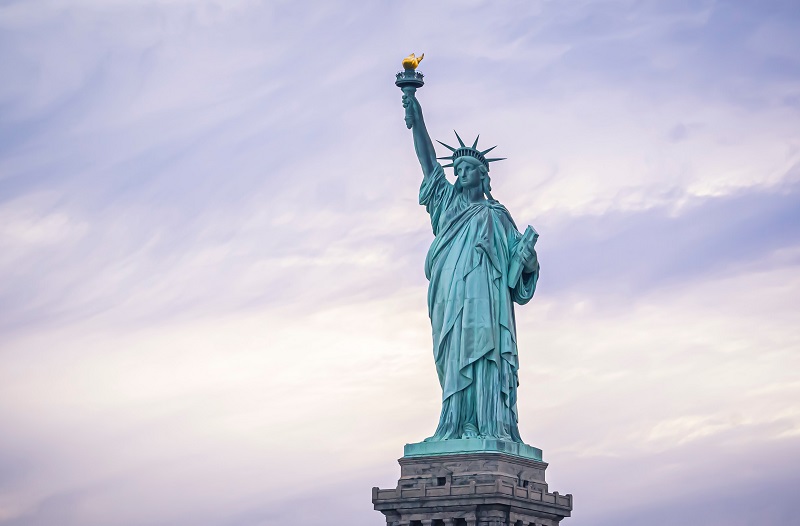
The Statue of Liberty is located on a small island in the entrance to New York. For many, it is a landmark and a symbol of both New York City and the United States. The 46 meter high statue was erected in 1886, and it was a gift from the French people on the occasion of the USA’s 100th anniversary. The original and much smaller Statue of Liberty can be seen on an island in the Seine in central Paris.
The huge statue was designed by Frenchman Frédéric Auguste Bartholdi. The statue represents the Roman goddess Libertas, who is the personification of freedom. The goddess carries a torch in one hand and a law book in the other. On it is written July 4, 1776, which is the date of the American Declaration of Independence. At the feet of the statue is a broken chain as a physical symbol of a freedom won.
Today you can take a walk around the statue on top of the high plinth and enjoy the view of New York City and over the harbor. Inside the massive plinth is a museum where you can take a closer look at the construction of the Statue of Liberty and the history of the monument. There is also limited access to the crown of the goddess, and until 1916 you could also visit the viewing platform around the torch.
The island on which the Statue of Liberty stands has been called Liberty Island since 1956. Previously it was known as Bedloe’s Island, which was named after Isaac Bedlow, who owned it from 1667. It came into the ownership of the city in the 18th century, and in 1800 it was sold to the federal government, which erected Fort Wood here as one of New York’s advanced defenses. Fort Wood’s star-shaped bastions today form the lower base of the Statue of Liberty. Formally part of Manhattan, the island remains today owned by the United States federal government.

Ellis Island is a small island that was the place where the ancestors of up to a third of the United States’ population first set foot on American soil. The facility on the island was a central reception point for immigrants in the period 1892-1924, when a total of more than 22 million people came to the island.
The current buildings were opened in the year 1900 in a fine French Renaissance style. The facilities were built to handle up to 5,000 people a day, but over the following decades the island’s capacity was continually expanded.
1907 was the year in which the most immigrants arrived. It amounted to a total of over a million, and in just one day, 11,747 people came to the site. In 1924, restrictions on immigration to the United States were introduced, and as a result Ellis Island’s function was gradually minimized to finally close in 1954.
The island was opened to visitors in 1976 and you can see the facilities and history of Ellis Island on a visit here. You can also look at family portraits and immigrant stories that put the great immigration to the United States in perspective.
Ellis Island was named after the merchant Samuel Ellis, who owned the island at the end of the 18th century, and whose heirs sold the island to the state of New York.

Staten Island is part of New York, and after a trip with the Staten Island Ferry you come ashore in almost rural areas with peaceful residential areas, parks and golf courses. From Staten Island and all the way across with the ferry from Battery Park, you also have a fantastic view towards New York City and to Ellis Island with the Statue of Liberty.
In addition to some beautiful and cozy neighborhoods and landscapes, there are several museums on Staten Island. This is, for example, the National Lighthouse Museum (5 Bay Street), which is located at the ferry’s arrival point. The museum depicts the history and significance of lighthouses.
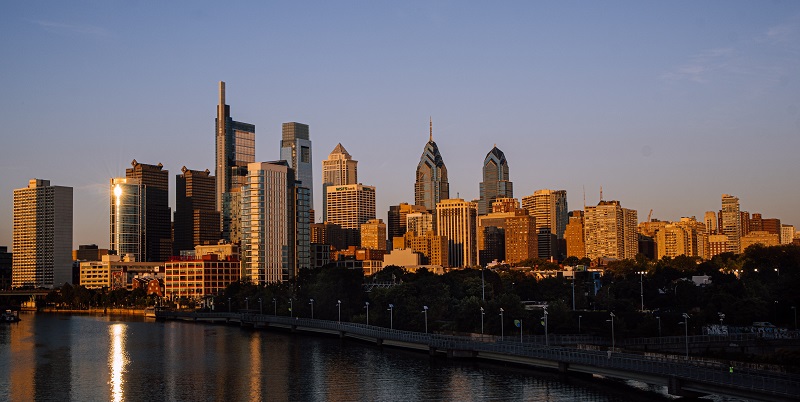
Philadelphia is one of the historically important cities of the United States, and it was even the capital of the country in the years 1790-1800. In the town of the Delaware River, there are countless sights and lots of early American history that give intriguing impressions from the time around the American Revolution.
It was in Philadelphia that the American Declaration of Independence of Great Britain was adopted, and in that way the city has a special status in the history of the United States. This can be looked at in more detail in Independence Hall, which formed the setting for both the declaration and for the adoption of the US Constitution.
1000 Third Avenue
bloomingdales.com
22 Cortlandt Street
c21stores.com
5100 Kings Plaza
kingsplaza.com
424 Fifth Avenue
lordandtaylor.com
Herald Square
macys.com
6th Avenue/3rd Street
manhattanmallny.com
90-15 Queens Boulevard
shopqueenscenter.com
611 Fifth Avenue
saksfifthavenue.com
2655 Richmond Avenue
Statenisland-mall.com
693 Fifth Avenue
ny-takashimaya.com
Fifth Avenue, Madison Avenue, Orchard Street, South Street Seaport, Times Square
American Museum of Natural History
Central Park West/79th Street
amnh.org
Astroland, Coney Island
1000 Surf Avenue, Brooklyn
astroland.com
Bowcraft Amusement Park
Scotch Plains, New Jersey
bowcraft.com
Bronx Zoo
2300 Southern Boulevard, Bronx
bronxzoo.com
New York Aquarium
602 Surf Avenue, Brooklyn
nyaquarium.com
New York Transit Museum
Grand Central Station
mta.info/mta/museum
USS Intrepid
Pier 86, W46th Street and 12th Avenue
intrepidmuseum.org
New York’s settled history begins with the first European to come to the interior of present-day New York. It was the Italian Giovanni da Verrazzano, and it happened in 1524. However, a settlement was not established on this occasion, as Verrazzano sailed on after, among other things, a meeting with the Lenape tribe who lived in the area.
Verrazzano later gave the first urban area the first European name; Nouvelle-Angoulême. It was in honor of the French king, who besides the royal title was the Count of Angoulême.
In September 1609, the Dutch ship Halve Maen entered in what is today the port of New York. Captain was the Englishman Henry Hudson, who was in Dutch service to find a sea route west to Asia. They did not find the sought after route, but they noted a large population of beavers.
Beaver fur was the highest fashion in Europe, and with the beavers of the coastal country, there was a source of income that could be exploited by the Dutch. They built trading stations in the New World, and the value and significance of the beavers can be seen to this day in New York’s city arms.
The Dutch colonies were founded, and among them was a fur trading station at today’s Albany. In connection with it, the area around present-day Manhattan was strategically good with ice-free shipping of furs.
In 1624 the first Dutch came to the new colony, which lay on the Noten Eylandt; today’s Governors Island. The southern tip of Manhattan was also colonized and the colony was named Nieuw Amsterdam the same year. In 1625 Fort Amsterdam was established, and in 1625 Peter Minuit purchased Manhattan and Staten Island by the Algonquin Indians. It laid the foundation for the development of the site.
Trade and settlements were constantly expanded; among other things, by means of African slaves, who during the 1700s became a large part of the new population.
Among the more well-known Dutch, Petrus Stuyvesant, among others, came to the colony. It was in 1647, when he became its Director-General; a position he held until 1664. The Director General was appointed by the company Geoctroyeerde Westindische Compagnie, which was a West Indian trading company based in Amsterdam.
Stuyvesant came to characterize the city’s early growth history, expanding Nieuw Amsterdam to the north and thus beyond the original colony at the southern tip of Manhattan. Thus, a canal was built where Broad Street is today, a wall along Wall Street and Broadway itself.
In 1664 British ships came to Nieuw Amsterdam and conquered the city, and formally Britain was assigned to the colony by the peace treaty in Breda, which in 1667 marked the end of the Second English-Dutch War. The city was renamed and now came to be called New York; named after the Duke of York.
A short transition, New York became Dutch again in 1673, but the final Dutch exit happened the year after the colony was swapped with Suriname in South America. New York then became a crown colony in 1685.
Throughout the 18th century, the city was continuously expanded with construction of homes, churches, administrative buildings, harbor facilities, etc.
In the 1740s there lived about 10,000-15,000 including about 20% of African slaves. The population of the city increased significantly over the century, and by the first census that took place in 1790, 30,000 people lived here.
Of larger institutions that saw the light of day was the educational site of King’s College, named after British King Charles II, later named Columbia University.
Increasing activity was also evident in the busy port that secured New York a leading position in the upland and also in the war that was on the way.
In the 1760s, the British introduced additional taxation of the American colonies with The Stamp Act, and it led the period 7-25. October 1765 the The Stamp Act Congress, a meeting of representatives of several of the colonies. The meeting was held in New York and was the first major and coordinated protest with British rule.
In 1776, some North American colonies who wanted independence from England came to war. The Declaration of Independence itself had been adopted by the Continental Congress on July 4, 1776. With that declaration, 13 colonies in the present United States considered themselves independent and thus not part of the British Empire.
On August 27, 1776, the first real battle took place in the American War of Independence. General George Washington had defeated the British by a siege of Boston, and he went with his army to the strategically important port city, New York, to which the English could continually obtain supplies for the navy and the army sailed forward.
During the Battle of Long Island, the British won, which they repeated at the Battle of Fort Washington. New York was the British’s main bridgehead, and it was a loyal city to English rule.
Despite the defeat, with the end of the war, the United States became independent, and New York also became part of the country. British troops remained in the city until 1783, when George Washington came here at the same time as the British retreat of the last soldiers.
War years had come at a distance, and the new country was to establish its own structures. In 1788, New York became the first capital of the United States, and in 1789 George Washington was inaugurated as the country’s first president at a ceremony in the Federal Hall on Wall Street. The first Supreme Court was also established here in the city, which was dominant in the US from the start. In 1790, however, the city’s status of capital passed to Philadelphia, and later Washington was established as a federal metropolitan area.
New York’s roots as a Dutch colony in the southern tip of Manhattan continued to be central to the city’s infrastructure, but large-scale growth and migration pushed for the city to expand significantly.
Thus, a visionary city plan from 1811 laid out all of northern Manhattan following a grid system for new urban areas, and the great immigration of the period created a great increase in population.
In 1819-1825, the city’s strategic position was strengthened with the construction of the Erie Canal waterway, which connected New York along the Hudson River and thus the city with the major agricultural areas of the Midwest and Canada. The new shipping route through Lake Erie, through the canal and to New York brought increased trade and growth.
The city was booming and people were moving to. In 1835, New York became the United States’ largest city with more than 150,000 inhabitants; thus Philadelphia had been overtaken in size.
In 1835, the old Dutch quarter burned to the ground, but the area was quickly redeveloped and there were virtually no limits to the growth of the city.
Large population groups joined; for example, many Irishmen who fled the famine in their homeland. New York’s share of Irish rose to a quarter in the mid-1850s, and new schools and other institutions were built for both them and other immigrants.
During the American Civil War, the city sympathized with the north and the south. There were many good trade links and familial ties to the southern states, and in 1863 this led to great civil unrest. The retention of the American Union was muted and New York could continue its thriving development.
In the latter part of the 19th century, millions of European immigrants came to the United States, and most of them arrived through New York harbor. The first meeting with the United States was changed from 1886 with the erection of the Statue of Liberty, a gift from France on the occasion of the 100th anniversary of the United States.
New York’s area was expanded over several times up to 1900, and new neighborhoods like the Bronx were built. In 1898, Greater New York was created by the amalgamation of many municipalities, and the city’s population grew by that opportunity to 3.5 million. The large population and thriving economy created a great deal of pressure on Manhattan as the center, and building closer and higher. The first skyscrapers shot up, and the city’s subway opened in 1904.
The skyscrapers were rapidly being built, and Manhattan’s skyline changed with the many new buildings. Underground, the city’s first subway line opened in 1904, and over time the line network has expanded rapidly with the city counting more than 400 stations.
New York’s economic growth was slowed by the stock market crash of 1929, which began the 1930s depression. Time created endless queues of unemployed, poor New Yorkers. However, major construction projects such as the Empire State Building, inaugurated in 1931, were completed.
UN headquarters was located in New York after World War II. The subsequent period was marked by a slowdown and rising problems of crime and disharmony between ethnic groups. Many people moved to the new suburbs and companies moved.
By 1975, the city was nearing bankrupt, and in the 1980s development was stagnant at best. It wasn’t until the 1990s that the city’s budgets were surplus. New jobs were created and previously stressed areas were refurbished and made attractive again.
As two passenger aircraft flew into the World Trade Center’s two twin towers in New York, the entire world was affected and changed. Thousands were killed, and materially the city’s tallest buildings collapsed into gravel, leaving the site of the ground Zero, after a colossal cleanup, where a new skyscraper complex is erected with the usual American will and pursuit.
Today’s New York continues to be the gateway to many of the United States, and it is still the largest city in the United States with a global outlook not to be found anywhere in the world.
 Brooklyn Bridge, New York City, USA[/caption]
Brooklyn Bridge, New York City, USA[/caption]
Overview of New York City
New York City is a metropolis, also known as the Big Apple, and it is the epitome of the United States and much of what the United States stands for in diversity, opportunities and freedom. It is an international metropolis that attracts tourists from all over the world all year round, and there is always something exciting to see and do in this, the largest American city.
Upon entering the city the Statue of Liberty stands as a symbol of the land of the free and the American dream, which has always been popular among immigrants and tourists alike. The statue goddess overlooks Manhattan’s mix of the many classic and modern skyscrapers, bridges, rivers and many other sights and features.
It was in New York and Chicago, the world’s first and tallest classic high-rise buildings were built, and it happened fast and ever higher through the 20th century. Among the most famous skyscrapers, you can see the Chrysler Building and the Empire State Building from the peak of skyscraper designs on the first part of the 1900s. One World Trade Center is the tallest and the most famous modern high-rise in the city.
About the Whitehorse travel guide
Contents: Tours in the city + tours in the surrounding area
Published: Released soon
Author: Stig Albeck
Publisher: Vamados.com
Language: English
About the travel guide
The Whitehorse travel guide gives you an overview of the sights and activities of the Canadian city. Read about top sights and other sights, and get a tour guide with tour suggestions and detailed descriptions of all the city’s most important churches, monuments, mansions, museums, etc.
Whitehorse is waiting for you, and at vamados.com you can also find cheap flights and great deals on hotels for your trip. You just select your travel dates and then you get flight and accommodation suggestions in and around the city.
Read more about Whitehorse and Canada
Canada Travel Guide: https://vamados.com/canada
City tourism: https://visitwhite-horse.ca
Main Page: https://www.vamados.com/
Buy the travel guide
Click the “Add to Cart” button to purchase the travel guide. After that you will come to the payment, where you enter the purchase and payment information. Upon payment of the travel guide, you will immediately receive a receipt with a link to download your purchase. You can download the travel guide immediately or use the download link in the email later.
Use the travel guide
When you buy the travel guide to Whitehorse you get the book online so you can have it on your phone, tablet or computer – and of course you can choose to print it. Use the maps and tour suggestions and you will have a good and content-rich journey.

Battery Park is a beautifully situated oasis, from which there is also a lovely view of the water and to the skyscrapers of the financial district. Battery Park is named after the cannon batteries that were located here in the past, and which formed the city’s defense against the waterfront.
In Battery Park you can see the fortress Castle Clinton, which was built in the years 1808-1811. Originally it was in the water as a sea fort, but landfills have made it land-locked. In 1821 the fort closed as a military facility, and over time there has been a theater and an aquarium here. Today it is a visitor center where you can explore selected parts from New York’s history.

World Trade Center is synonymous with the attack on September 11, 2001, when planes were flown into the twin towers, which then constituted the World Trade Center’s iconic buildings. Today, Ground Zero is where the twin towers of the World Trade Center stood until 2001, when two airliners were flown into the buildings and crashed, killing thousands.
The World Trade Center was a complex consisting of a total of seven buildings, of which the 417 meter high twin towers were the most famous and which marked the peak of the city’s profile. The construction of the towers lasted from 1966 to 1971, and as mentioned, they were destroyed during the attack on the United States in 2001.
In 2006, the Port Authority, which owns the site, began construction of the foundation for the site’s new tallest building, named One World Trade Center. Also known as the Freedom Tower, One World Trade Center was officially opened in November 2014. One World Trade Center’s roof reaches a height of 417 meters, while the tip of the building’s antenna extends to 541 meters, making the building one of the world’s tallest buildings.
The height itself is symbolic in two ways. The 541 meters is equal to 1,776 US feet, which is the same number as the year of the signing of the American Declaration of Independence. The 417 meters is the same height as the original twin towers of the World Trade Center.
At the former location of the twin towers, a national memorial has been established today for those who died on September 11, 2001. The opening took place on the tenth anniversary of the attack, and the memorial is called the National September 11 Memorial & Museum, and it consists of a park around the site of the two crashed twin towers. The very site of the former outer walls of the two towers is marked by two rectangular basins; North Pool and South Pool. The site’s museum opened in 2014 and depicts September 11, 2001 through objects, stories, photographs and more.
Saint Paul’s Chapel is a charming church built in 1766. Back then, the church was outside the city and served as a church for those who lived in the countryside. It was Britain’s Queen Anne who donated the land for what is now Manhattan’s oldest surviving church.
The building style was Georgian, and the church was inspired by buildings in London such as St Martin-in-the-Fields. St Paul’s Chapel has a classic columned hall as a facade, and behind it you can experience an elegant and bright interior.
Among the churchgoers over time have been America’s first president, George Washington, and the later King William IV of England. Washington even visited the church on his inauguration day as president, which was April 30, 1789. In and around the church you can see several monuments erected to some of the people who have been important to the country or to the church.
In connection with the attack on New York in 2001, when the World Trade Center’s skyscrapers crashed into rubble almost next door to Saint Paul’s Chapel, the church was completely intact, and there was not even a broken window. It was therefore natural that the church was used as a kind of refuge on top of the events that had taken place.

The Flatiron Building was erected in 1903 as the tallest building in the world. It was one of the first modern skyscrapers to use a steel skeleton in the construction to achieve the previously unseen heights. Daniel Burnham from Chicago was the architect of the innovation, and the architectural style was inspired by both Renaissance mansions and the Beaux-Arts of the time.
The Flatiron Building was not just one of the early pioneering high-rise buildings, it was also an example of the Chicago School style in New York. The Chicago School differed from the New York architectural style by being built like a now classic skyscraper without a separate base and with large glass sections without much use of decoration.
Opposite the building is a small and cozy park in Madison Square, where many locals go for a walk or sit and relax. Here you can see a number of statues that were erected in the 1800s.

Woolworth Building is one of New York’s oldest skyscrapers, and one of the most beautiful and best-known high-rises. The building, with its impressive 55 floors and 241 metres, was already constructed in the years 1910-1913. The style was inspired by Europe’s soaring Gothic.
The building was designed by the architect Cass Gilbert and erected as the headquarters of the Woolworth company. Woolworth was not least known for its department stores of the same name, and it was Frank Woolworth who started construction after purchasing the land in 1910.
Upon its opening in 1913, the Woolworth Building assumed the distinguished status of the world’s tallest building. Incidentally, the lights were officially lit by President Woodrow Wilson at the inauguration, and it happened from the capital Washington.
The building’s exterior is matched by an elegantly decorated interior, where the lobby stands as one of the most beautiful from the early 20th century in New York City. Frank Woolworth’s preserved office, kept in the French Empire style, is another attraction in the building.

City Hall is New York’s seat of the city administration and it dates from 1812. It is one of New York’s most architecturally elegant buildings, and it stands in the middle of the lovely oasis that is the surrounding City Hall Park. The park, with its trees and fountains, is a true breather between the tall buildings that surround the facility.
The building style of the town hall is like a mansion from the American southern states. The lobby is beautiful with its rotunda, columns and staircase. The building houses New York’s mayor’s office and is where the city council have their meetings, making it the oldest functioning city hall in the United States. There are also a number of works of art in the town hall like John Trumbull’s painting of Alexander Hamilton. This work adorns the US 10 dollar bill today.
There are many historical events that have taken place in the city hall building. One of the most famous was when the assassinated President Abraham Lincoln lay on lit de parade in the building after his death in 1865.
New York’s first City Hall was built by the Dutch in the 17th century near the current address of 73 Pearl Street. The second town hall was completed in 1700 at the corner of Wall Street and Nassau Street. It was Federal Hall, which was demolished in 1812. Since then, the current City Hall has served as the city’s administrative seat.

Manhattan Bridge is one of the great old bridges over the East River between the boroughs of Manhattan and Brooklyn. Opened in 1909, the suspension bridge was constructed on two levels, with road lanes at the top and mixed traffic with road lanes, railway tracks, cycle paths and footpaths at the bottom.
The total length of the bridge is 2,090 metres, and the free span between the pylons is 448 metres. From bank to bank of the East River, which despite its name is a strait and not a river, is 890 meters.
As a grand entrance to the bridge and as part of the contemporary urban beautification project called City Beautiful, the firm Carrère and Hastings designed a triumphal arch with two colonnades. It was completed in 1915 and can still be admired on the Manhattan side of the impressive suspension bridge.

Intrepid Sea-Air-Space Museum is a museum located on and around the American aircraft carrier USS Intrepid, which was in active service 1943-1974. The ship was involved in the Pacific War during World War II and later also participated in the Vietnam War. The ship was fitted out as a museum ship in 1982.
In addition to being able to experience an impressive aircraft carrier, you can also see other things. For example, the submarine USS Growler is also located here, it was in service 1958-1964. It was part of the navy’s reserve until 1980, and it was then intended to use it as a torpedo target. It was not carried out and instead visitors to New York can now look at it.
There are also airplanes in the exhibition. You can see a British Airways Concorde (G-BOAD) that flew between London and New York. Concorde was the world’s second supersonic passenger plane after the Soviet Tupolev 144. Of military aircraft, you can see, for example, an F-16, Lockheed A-12, an AV-8C Harrier and a MiG-17. Of the other aircraft, the space shuttle Enterprise came to the museum in 2012, and there is thereby also space travel history here in the middle of New York.
South Street Seaport is a central part of New York’s old harbor area, which is now renovated and full of a variety of attractions. Pier 17 is a center with a number of shops and eateries. The center is right next to the harbor, where you can enjoy a very nice view of the Brooklyn Bridge and go on a boat trip in the harbor.
In the area you will also find the maritime museum, South Street Seaport Museum, where you can see historic ships and get an overview of the history of the port of New York. The Titanic Memorial Lighthouse is also located here, which is a lighthouse that was erected in 1913 in memory of the victims of the sinking of the luxury liner Titanic. Schermerhorn Row is interesting to see as well. It is a series of houses that were built in 1811 as warehouses.
In 2012, the South Street Seaport was significantly damaged after Superstorm Sandy. The local museum had to close for a time, and a number of shops had to close. In 2013, the distinctive Pier 17 building was demolished. A new building has since been erected, and there is access to the new surroundings in the well-located location.

Rockefeller Center is a building complex that the wealthy John D. Rockefeller built in the years 1930-1939. Back then, the centre’s original 14 buildings were built, and today the complex has been expanded to 19 buildings. The style is art deco, and the harmony between the buildings and the streets is particularly fine, which makes the place much visited by New Yorkers.
Originally, it was Rockefeller’s idea to let a new opera house for the Metropolitan Opera form part of a building complex, but after the stock market crash in 1929, he chose to go ahead as the only one to finance a large construction here. It then also became the largest privately financed project in the world at the time, and it was in this connection that the first 14 buildings were erected with Raymond Hood as lead architect.
In 1931, John D. Rockefeller was suggested the name Rockefeller Center, which he did not want at first, but due to the consideration of being able to attract more tenants, it was adopted. Thus, the place housed a number of offices, and part of the center also formed intelligence headquarters during World War II, which happened in Room 3603.
In the 1960s and 1970s, the number of buildings was expanded from 14 to 18 with the construction of four building towers in the contemporary international style, and today there are 19 buildings in the large complex.
There is quite a bit of art around Rockefeller Center. For example, you can see works by Lee Lawrie, who among other things created the statue of Atlas, which can be seen towards the street 5th Avenue. You can also notice some reliefs such as Isamu Noguchi’s News, which can be seen at the Associated Press Building (50 Rockefeller Plaza).
One of the best-known works of art is probably Paul Manship’s gilded bronze statue of the titan Prometheus, who in Greek mythology gave fire to mankind. It can be seen at the Lower Plaza, which is also the setting for the complex’s popular skating rink. At Christmas time, it is also something special to see the center in its entirety, which is characterized by beautiful illumination and a fantastic New Yorker atmosphere.

Central Park is New York’s large city park, measuring 4,000×800 metres. The park was planned by the city council in 1853 and laid out in the following years, when the city’s population almost exploded, and where people wanted a park like Hyde Park in London or the Bois de Boulogne in Paris.
In the park’s many nooks and crannies and on the many kilometers of footpaths, you can get a view of the recreation of many New Yorkers with, for example, jogging and various sports. You can also simply go for a walk in the beautiful surroundings and enjoy the view of many of the fashionable buildings that were built along the sides of the park over time.
In Central Park you can find several statues and sculptures such as those on the so-called Literary Walk with authors, and then there is the ancient Egyptian obelisk Cleopatra’s Needle, which came here as a gift from Egypt. The obelisk is one of a pair, the other standing in London, England. Each of them is 21 meters high and originates from Heliopolis from the time of Thutmose III around the year 1450 BC. The obelisks are of granite and their inscriptions date from the time of Ramses II in the 13th century BC.
In Central Park, there are artificial lakes, large lawns and the Belvedere Castle, built in 1869, which has functioned both as a viewpoint and as a weather station. There is also a zoo in Central Park, and there are many playgrounds for children. Many kids will probably nod in recognition to the Central Park Zoo, as it is the setting for large parts of the universe from the animated films in the Madagascar series.
With its large size, the park also attracts many birds and people interested in birds. All in all, it pays to take your time and relax and enjoy life during the trip in Central Park.

Harlem is a district named after the Dutch city of Haarlem. The explanation is that the borough was Dutch when it was established in 1658. In 1873, Harlem became part of New York, and from the beginning of the 20th century, the area has been known for its inhabitants and culture from New Yorkers of African descent.
With the economic crisis of the 1930s and the closure of many industrial workplaces in New York City after World War II, Harlem fell into disrepair and crime increased. From the end of the 20th century, however, there has been a cultural, social and economic flourishing here.
Harlem is a large area whose central street is 125th Street. Here you can see, among other things, the Apollo Theater (253 W 125th Street), which was built in 1913. Ella Fitzgerald made her debut in the theater, and others such as Buddy Holly, Michael Jackson and Paul McCartney have performed here.
Similar to New York City Travel Guide